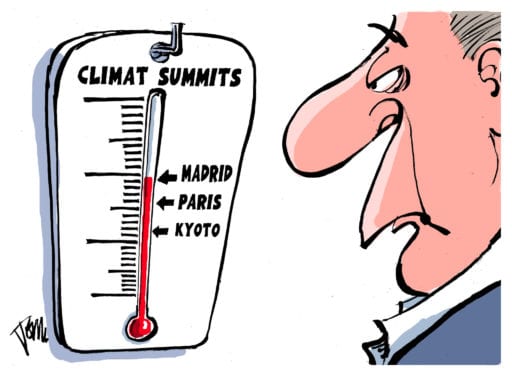BY MARK HERTSGAARD AND KYLE POPE
 Some good news, for a change, about climate change: When hundreds of newsrooms focus their attention on the climate crisis, all at the same time, the public conversation about the problem gets better: more prominent, more informative, more urgent.
Some good news, for a change, about climate change: When hundreds of newsrooms focus their attention on the climate crisis, all at the same time, the public conversation about the problem gets better: more prominent, more informative, more urgent.
In September, 323 news outlets from across the United States and around the world – including The Oklahoma Observer – collaborated to provide a week of high-profile coverage of the climate story, in the most extensive such project on record. The collaboration was organized by Covering Climate Now, a project co-founded by Columbia Journalism Review and The Nation. Participants included The Guardian, the project’s lead media partner, and some of the biggest newspapers, television, and radio stations, and online news sites in the world: Bloomberg, CBS News, Agence France Presse, The Times of India, El País, Asahi Shimbun, Nature, WNYC, WHYY, HuffPost, National Observer, Univision, Al Jazeera, Harvard Business Review, and Scientific American. Joining them was an array of smaller, often nonprofit outlets hailing from Alabama to Alaska and Turkey to Togo. Representing 47 countries and much of the United States, these 323 outlets reached a combined audience of well over one billion people.
Over the course of the week surrounding the United Nations Climate Action Summit on Sept. 23, Covering Climate Now outlets published or broadcast at least 3,640 stories about climate change. Social media sharing of Covering Climate Now stories was widespread, with 69,623 individual tweets and 1.93 billion total impressions.
The reach is likely much higher when factoring in stories distributed by news agencies around the world. One, Agence France Presse, distributed 1,200 text stories [in the six languages in which AFP publishes] to its thousands of newsroom clients around the world; it also made available 2,000 photos, 391 videos, and 170 graphics. The magnitude of AFP’s climate coverage cannot be calculated without knowing how many clients picked up each of these items, “but the audience is clearly potentially in the billions, and we are increasingly seeing climate content being among the most used by [our] clients” says Phil Chetwynd, AFP’s global news director.
The median number of stories per outlet was seven, reflecting the fact that some smaller partners have only one or two staffers. [The Oklahoma Observer published 21 essays, which can be read by clicking here.] Larger outlets, however, more than compensated. “We ended up doing more than two dozen stories that wouldn’t have run except for this initiative,” said a senior editor at Bloomberg. The Guardian published more than 150 climate-related articles in its U.S., UK, Australian, and International editions.
All of which helped drive a much-needed increase in overall media coverage of the climate crisis. In September, “media attention to climate change and global warming was at its highest level globally in nearly a decade,” reported the Media and Climate Change Observatory program at the University of Colorado Boulder.
The watchdog group Media Matters for America commented about Covering Climate Now, “This initiative was unique in the depth and scope of its coverage, and many of the participating outlets touched upon climate change issues that have been either underreported or ignored in the media altogether.”
The Philadelphia Inquirer, for example, exposed what it called “the secret scourge of climate change” in the form of more sewage in the city’s waterways as bigger storms overwhelmed drainage capacity. Rolling Stone revealed how agribusiness is blocking climate action by family farmers.
El País, Spain’s leading newspaper, devoted an entire issue of its weekly magazine to “La Battala Por El Planeta” [The Battle for the Planet]. Asahi Shimbun, one of Japan’s largest newspapers, reported that record heat may make it very difficult to hold the 2020 Summer Olympics in Tokyo as planned.
At least 185 of our outlets made their climate stories available at no cost for other partners to republish. The Guardian led the way, and more than 40 partners picked up its stories. This content sharing meant that readers, viewers, and listeners got access to more and higher quality climate coverage than any single outlet could provide on its own. The on-camera interview UN Secretary General António Guterres gave the partnership, which was shot by CBS News and made available in both English and Spanish versions, is one such example.
Now, in addition to facilitating other joint coverage collaborations, Covering Climate Now aims to encourage better news coverage of the climate story by writing about that coverage and convening conferences where journalists can discuss and share best practices. Our own reporting and commentary will appear on the websites of Covering Climate Now and Columbia Journalism Review and also be offered for free to any Covering Climate Now outlet that wishes to republish them.
The goal is to make the climate story a routine part of daily news coverage, rather than a subject addressed only on special occasions. KQED, the biggest public radio station in the San Francisco Bay Area, has long been committed to strong climate coverage, but that coverage, KQED science editor Kat Snow told us, had been siloed at the science desk.
So KQED’s science reporters and editors will soon begin one-on-one meetings with their counterparts elsewhere in the newsroom to explain how to include the climate angle in their coverage. “We want to help our colleagues see that climate change is part of the story for every beat,” said Snow. “We’ll give them background information and story ideas to incorporate the climate angle in their coverage of housing or education or whatever beat they work.”
Finally, we will encourage our colleagues to grapple with the hard truths of climate science. Too often, news coverage has given political opinions precedence over scientific fact, blunting the public’s response. One welcome contrast is the approach taken by The Guardian and The Washington Post: When 11,258 scientists released a public letter in early November endorsing a peer-reviewed study warning that the planet “clearly and unequivocally faces a climate emergency,” both newspapers reported the story prominently on their homepages, with the words “crisis” and “emergency” in the headlines.
While much work still needs to be done, climate coverage does seem to have turned a corner. The climate silence that had long pervaded so much of the media has been broken. Now, the challenge is to improve the coverage. What do you wish your favorite news outlets would do to cover the climate story better? Send us your suggestions at coveringclimatenow@cjr.org.







